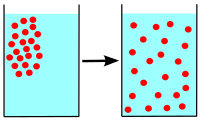
Photo from wikipedia
Abstract In the initial recovery stage, only 5 to 15% of hydrocarbons can be extracted from oil reservoirs, so it is necessary to supply energy from an external reservoir or… Click to show full abstract
Abstract In the initial recovery stage, only 5 to 15% of hydrocarbons can be extracted from oil reservoirs, so it is necessary to supply energy from an external reservoir or to use advanced solutions to increase oil recovery. By using secondary recovery method and flooding, greater amount of oil can be extracted. In this study, a new procedure of flooding using nanofluid was simulated. The nanofluid and source rock were modeled as a single phase and heterogeneous porous media, respectively. The geometry was considered as a two-dimensional rectangular area. Two phase Darcy equations and mass transfer equations were utilized to simulate this process. Moreover, the effects of different volume fractions of the nanofluid, the reservoir porosity, and absolute diffusion were studied. Considering the heterogeneous media, absolute diffusion is an important mechanism. Capillary pressure and permeability play an important role in the two phase Darcy equations. Furthermore, the effects of mechanical properties of inlet fluid such as viscosity and density on oil recovery factor were investigated. According to the results, it is possible to increase the oil recovery factor of the reservoir rock as a randomized heterogeneous porous environment more than 15% by adding 5% of the silicon nanoparticle to the fluid.
Journal Title: Journal of Molecular Liquids
Year Published: 2020
Link to full text (if available)
Share on Social Media: Sign Up to like & get
recommendations!